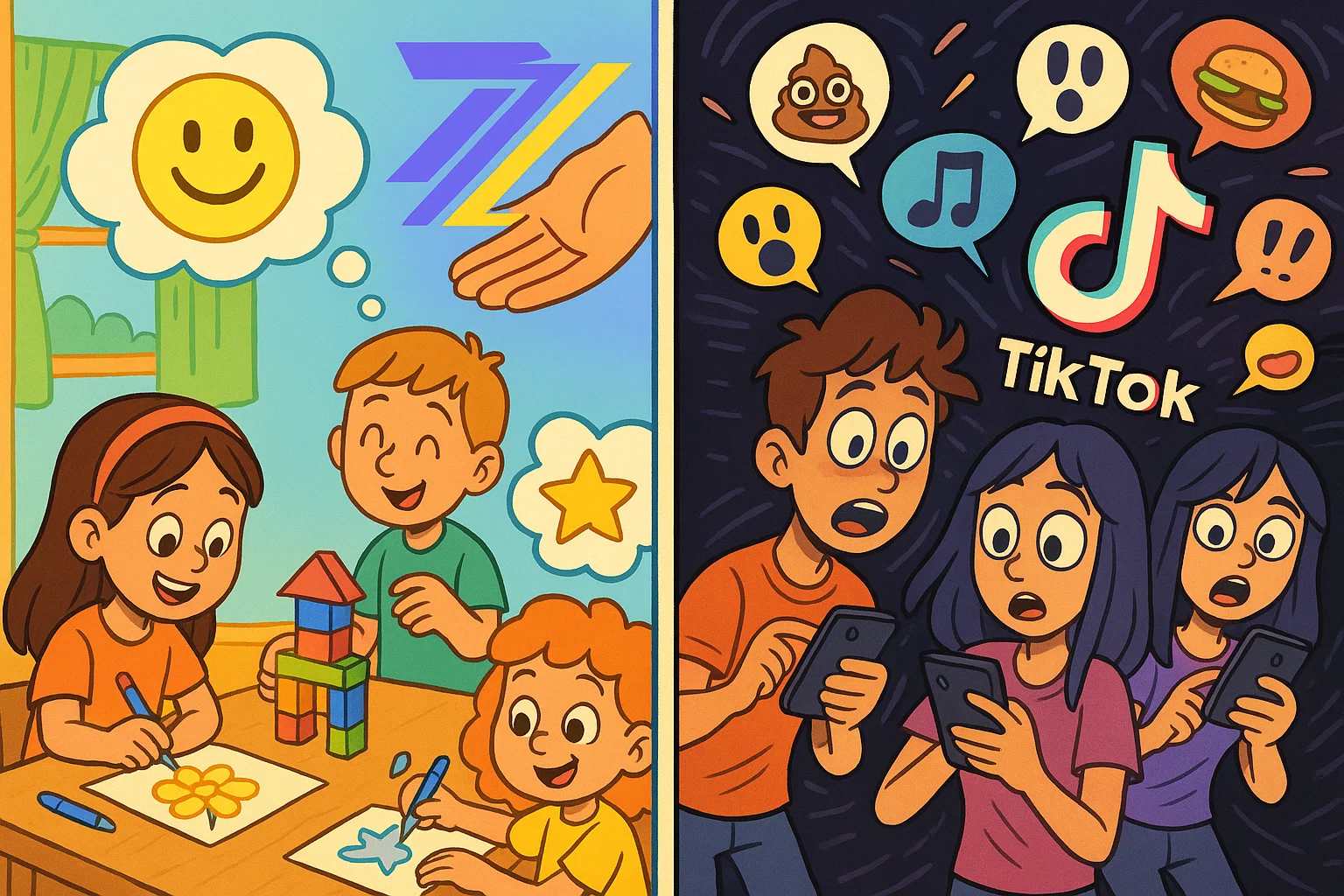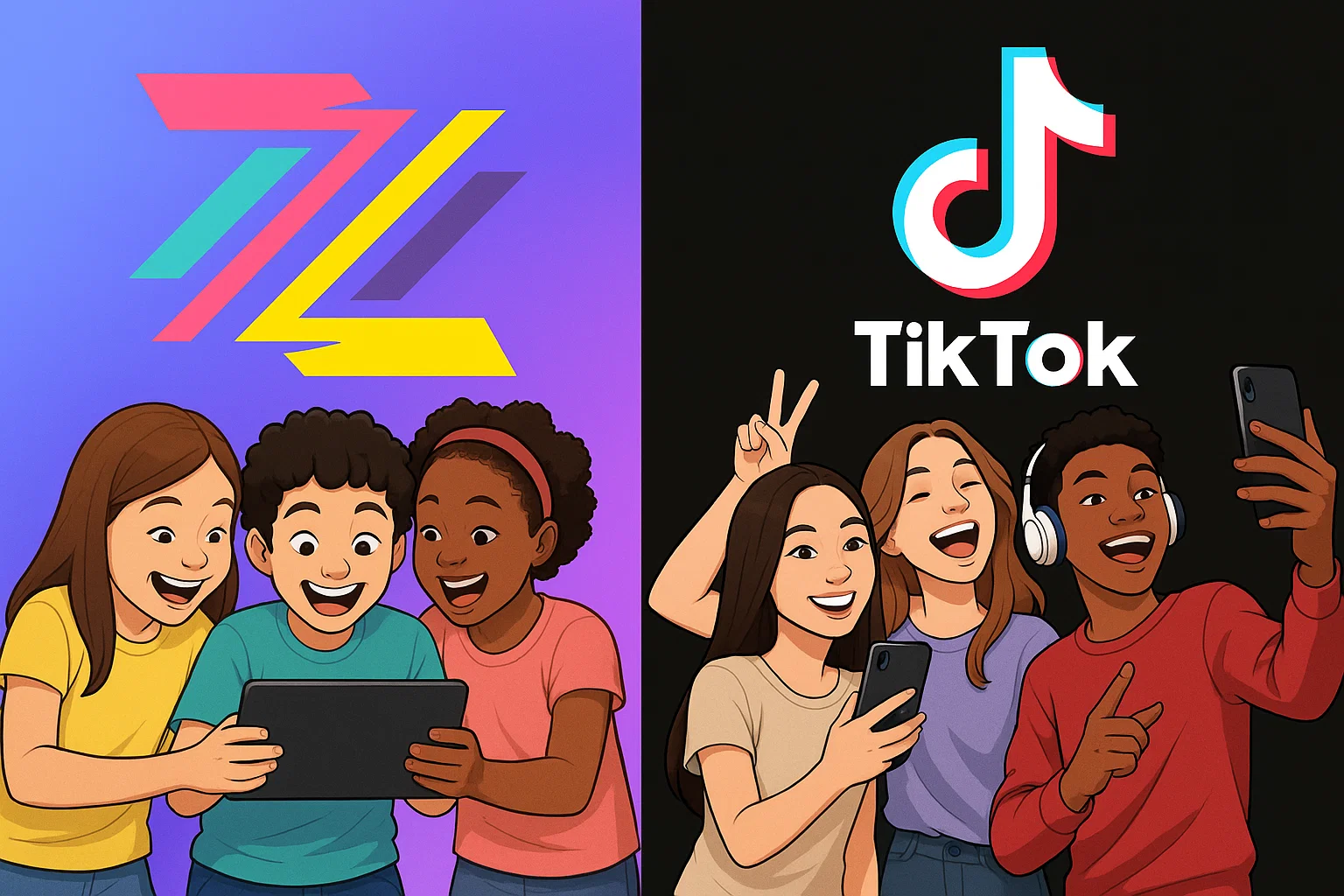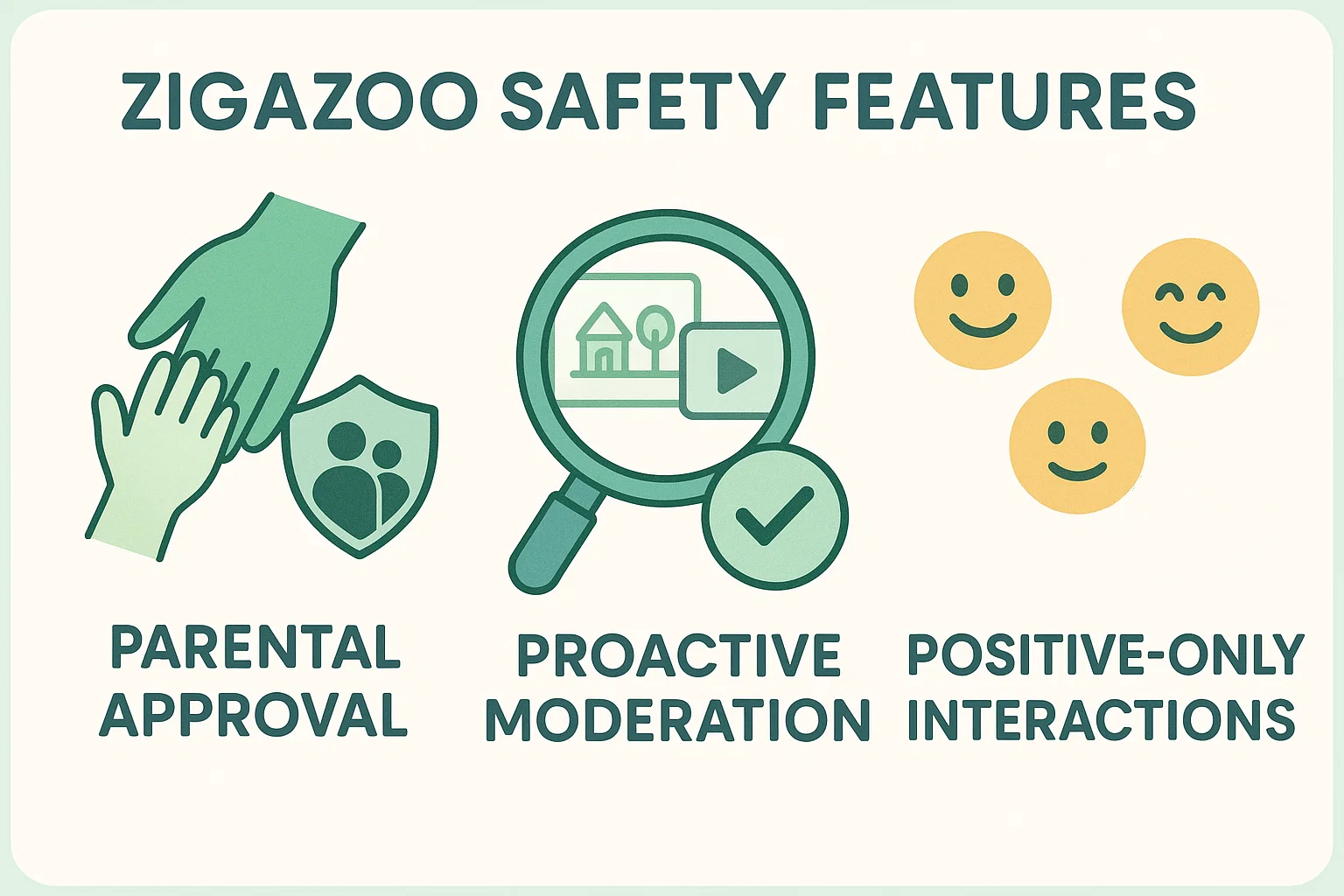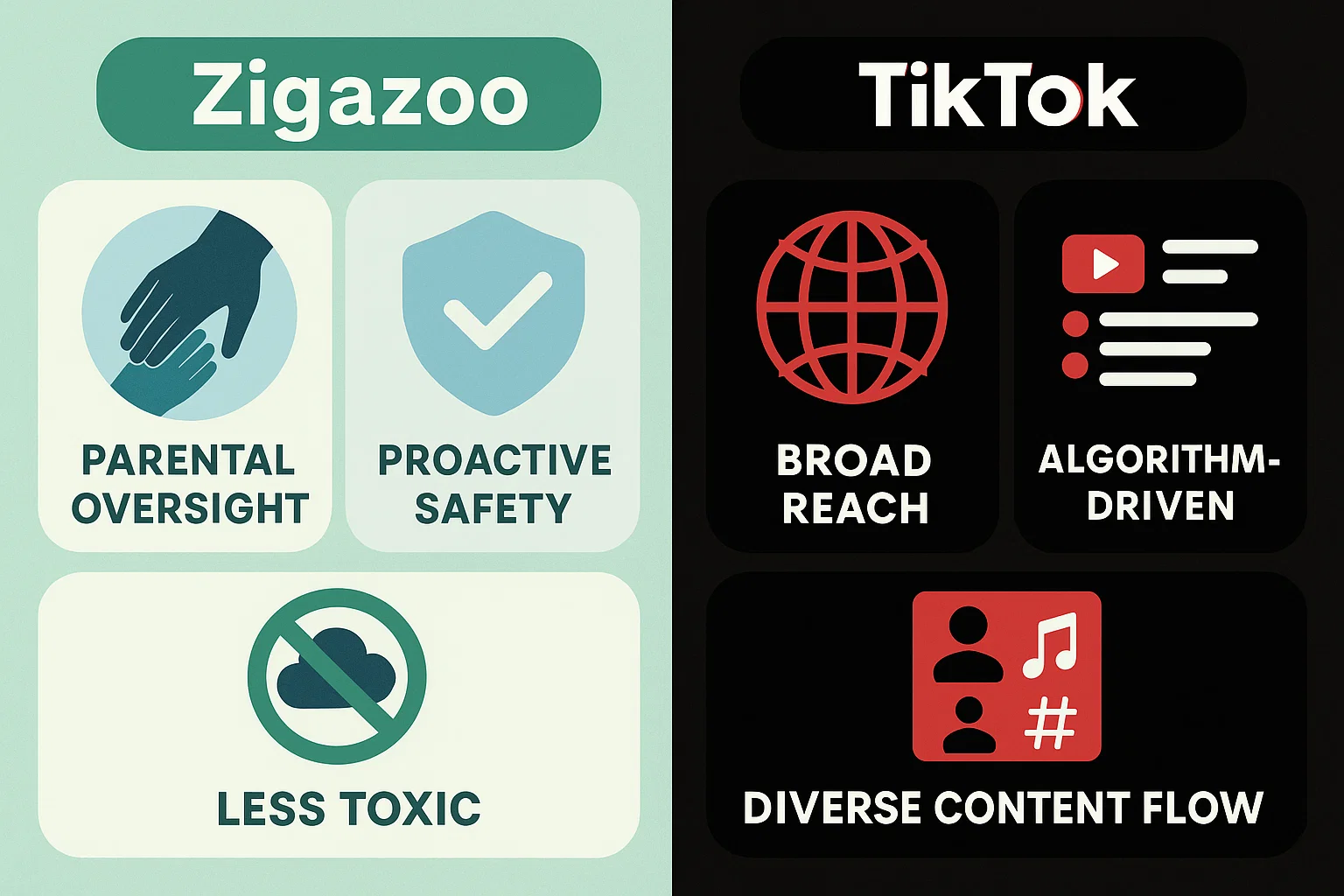Zigazoo vs TikTok: Social Media App Alternative for a New Generation

The social media landscape is rapidly evolving, with new platforms emerging to address growing concerns about digital safety and user well-being. As Generation Alpha comes of age and Generation Z consumers become increasingly mindful of their online experiences, the demand for healthier social media environments has never been stronger. This comprehensive comparison explores two distinct platforms: the established giant TikTok and the emerging alternative Zigazoo, examining their approaches to creating meaningful digital spaces for young users.
Zigazoo: Less Toxic TikTok Alternative? 🌟

Zigazoo has positioned itself as a safer, more positive alternative to traditional social media platforms. Unlike many mainstream apps that have faced criticism for their impact on mental health, Zigazoo was designed from the ground up with user safety and positive engagement in mind. The platform aims to create what many describe as “a social media oasis” – a space where young users can express creativity without encountering the typical toxicity found elsewhere.
The app’s approach differs significantly from TikTok’s open-ended format. Rather than allowing unlimited content creation and consumption, Zigazoo employs a more structured approach that encourages educational and creative activities. This methodology suggests that alternative social media platforms can successfully balance entertainment with user well-being.
What Makes Zigazoo Less Toxic?

Parental Control, Safety Features
Zigazoo’s safety framework centers on comprehensive parental involvement and robust protective measures. The platform requires parental approval for account creation and provides extensive oversight tools that allow parents to monitor their children’s online activities. These features include:
- Real-time content monitoring with parental notifications
- Comment approval systems that filter out potentially harmful interactions
- Limited direct messaging to prevent inappropriate contact
- Time-based usage controls to manage screen time effectively
Research indicates that platforms with strong parental control features may reduce the risk of cyberbullying and inappropriate content exposure, according to digital safety studies.
Community Guidelines, Content Moderation
The platform employs what industry experts call “proactive moderation” – a system that reviews content before it becomes publicly visible. This approach contrasts sharply with reactive moderation used by larger platforms, where harmful content is addressed only after users report it. Zigazoo’s moderation strategy includes:
| Moderation Feature | Implementation | Impact |
| Pre-publication review | All content screened before posting | Prevents harmful content from reaching users |
| AI-powered filtering | Automated detection of inappropriate material | Reduces human moderator workload |
| Community reporting | User-friendly reporting mechanisms | Enables community self-regulation |
| Expert review panels | Child development specialists evaluate policies | Ensures age-appropriate standards |
What is Zigazoo?
Zigazoo History, Purpose
Zigazoo launched with a clear mission: to create a social media platform tailored for younger audiences without the typical risks associated with mainstream apps. The platform was founded by parents and educators who recognized the need for a safer digital environment where children could explore creativity and connect with peers in meaningful ways.
The app’s development was influenced by research showing that many Gen Z users wanted to create a social media experience that prioritized mental health over viral content. This insight led to the creation of features that encourage positive interactions and educational content consumption.
Target Audience: Generation Alpha, Beyond
While initially designed for ages 13 and younger, Zigazoo has expanded its appeal to include older teens and young adults seeking alternatives to traditional social media platforms. The platform’s Alpha-focused approach recognizes that this generation has different digital expectations and safety requirements compared to previous cohorts.
Generation Alpha users, having grown up with heightened awareness of online safety issues, tend to appreciate platforms that prioritize their well-being over maximum engagement. This demographic shift suggests that future social media platforms may need to adopt similar safety-first approaches to remain relevant.
TikTok: Reigning Social Media Trend
TikTok Influence on Digital Culture
TikTok’s impact on social media culture cannot be overstated. The platform has fundamentally changed how users consume and create content, introducing the concept of algorithmic content delivery that keeps users engaged for extended periods. Popular TikTokers have built massive followings and influenced trends across multiple industries.
However, this influence comes with significant concerns. Studies indicate that social media makes many users feel anxious, with TikTok’s algorithm particularly noted for its potential to amplify negative content or create unrealistic expectations for young users.
Content Diversity, Reach
TikTok’s strength lies in its vast content diversity and global reach. The platform allows users to:
- Create content across unlimited topics and formats
- Reach potentially millions of viewers through algorithmic distribution
- Participate in viral trends and challenges
- Monetize their content through various creator programs
This diversity, while appealing to many users, also creates challenges for content moderation and user safety, particularly for younger audiences.
Monetization, Creator Economy
TikTok has established a robust creator economy that provides financial incentives for content production. This system has created opportunities for young creators to generate income from their content, but it also introduces pressure to create increasingly engaging (and sometimes controversial) content to maintain relevance.
The monetization model may encourage behaviors that prioritize viral content over user well-being, a concern that alternative platforms like Zigazoo aim to address through different incentive structures.
Safer Social Media: Is It Possible? 🔒
Data Collection, Privacy Concerns
Both platforms collect user data, but their approaches differ significantly. TikTok’s data collection practices have faced scrutiny from regulators and parents concerned about privacy and data security. Zigazoo, by contrast, emphasizes minimal data collection and transparent privacy policies designed for younger users.
Key privacy considerations include:
- Data retention policies and how long user information is stored
- Third-party sharing of user data with advertisers or other companies
- Location tracking and its implications for user safety
- Parental access to their children’s data and account information
Cyberbullying, Online Harassment
Cyberbullying remains a significant concern across all social media platforms. Research shows that platforms with larger user bases and open commenting systems tend to have higher rates of harassment. Zigazoo’s approach to preventing cyberbullying includes:
- Limited commenting capabilities to reduce opportunities for harassment
- Positive reinforcement systems that encourage supportive interactions
- Quick response protocols for addressing reported incidents
- Educational resources for users and parents about online safety
Balancing Engagement, Well-being
The challenge for any social media platform is maintaining user engagement while protecting mental health. TikTok’s algorithm is designed to maximize time spent on the platform, which can lead to excessive screen time and potential negative impacts on well-being. Zigazoo attempts to balance engagement and well-being through:
- Built-in usage limits that encourage breaks from the platform
- Positive content algorithms that prioritize educational and uplifting material
- Wellness features that promote healthy digital habits
- Community guidelines that emphasize supportive interactions
Choosing Your Platform: Zigazoo vs TikTok

Content, Community Comparison
When comparing content and community aspects, the differences between these platforms become clear:
TikTok offers unlimited creative freedom with access to trending music, effects, and global audiences. The platform’s community is diverse and constantly evolving, with new trends emerging daily. However, this openness can also expose users to inappropriate content or negative interactions.
Zigazoo provides a more curated experience with educational prompts and family-friendly content. The community is smaller but more focused on positive interactions and learning. Users may find less variety in content but experience fewer negative encounters.
Privacy, Security Features Face-Off
Privacy and security represent perhaps the most significant differences between these platforms:
| Feature | TikTok | Zigazoo |
| Age verification | Basic self-reporting | Parental verification required |
| Content moderation | Post-publication review | Pre-publication screening |
| Data collection | Extensive for personalization | Minimal, focused on safety |
| Parental controls | Limited options | Comprehensive oversight tools |
| Direct messaging | Available with some restrictions | Highly restricted or unavailable |
User Experience, Interface
The user experience differs significantly between platforms. TikTok’s interface is designed for rapid content consumption with infinite scroll capabilities and sophisticated recommendation algorithms. Zigazoo’s interface emphasizes safety and educational value over engagement metrics, with clearer navigation and fewer distracting elements.
Users seeking entertainment and viral content may prefer TikTok’s dynamic interface, while those prioritizing safety and educational value may find Zigazoo’s approach more suitable.
Zigazoo as Promising Alternative ✨

Why Some Users Prefer Zigazoo
Several factors contribute to Zigazoo’s appeal as an alternative social media platform:
- Safety-first approach that prioritizes user well-being over engagement metrics
- Educational focus that combines entertainment with learning opportunities
- Parental involvement that provides peace of mind for families
- Positive community culture that encourages supportive interactions
- Transparent policies that clearly communicate platform rules and expectations
Many parents and educators view Zigazoo as a stepping stone that allows young users to develop healthy digital habits before transitioning to more complex platforms.
Future of Social Media: New Trend?
The emergence of platforms like Zigazoo suggests a broader trend toward safer, more intentional social media experiences. As awareness of digital wellness grows, users increasingly seek platforms that align with their values and priorities.
This shift may indicate that future social media platforms will need to balance engagement with user safety more effectively. The success of alternative platforms could influence how established companies approach content moderation, user safety, and community building.
Impact on Generation Z, Alpha
Generation Z consumers and Generation Alpha users are driving demand for healthier social media environments. These generations have grown up with increased awareness of digital wellness issues and are more likely to seek platforms that support their mental health and educational goals.
The impact of safer social media platforms on these generations may include:
- Improved digital literacy through educational content and positive interactions
- Better mental health outcomes due to reduced exposure to toxic content
- Enhanced creativity through structured, supportive creative challenges
- Stronger family connections through increased parental involvement in digital activities
Conclusion: Evolving Social Media Landscape 🌅
Key Differences Recap
The comparison between Zigazoo and TikTok reveals fundamental differences in approach, priorities, and user experience. TikTok offers unlimited creative freedom and global reach but comes with significant safety and privacy concerns. Zigazoo provides a safer, more controlled environment that prioritizes user well-being and educational value over viral content and maximum engagement.
Key differences include:
- Safety measures: Zigazoo’s comprehensive approach versus TikTok’s basic protections
- Content moderation: Proactive screening versus reactive response
- User experience: Educational focus versus entertainment-driven algorithm
- Community culture: Positive reinforcement versus competitive engagement
- Privacy approach: Minimal data collection versus extensive personalization data
Future Outlook for Both Platforms
The future of social media will likely involve continued evolution toward safer, more intentional platforms. TikTok may need to adapt its approach to address growing safety concerns and regulatory pressure. Zigazoo and similar alternatives may expand their offerings while maintaining their safety-first principles.
The success of either platform will depend on their ability to meet users’ evolving expectations for digital wellness, safety, and meaningful engagement. As Generation Alpha continues to mature and Generation Z consumers become more discerning about their digital choices, platforms that prioritize user well-being alongside entertainment value are likely to find sustained success.
The ongoing development of these platforms represents a broader shift in how society approaches social media, moving from a model focused primarily on engagement and monetization toward one that balances these goals with user safety and positive community building. This evolution suggests that the future of social media may be less toxic and more aligned with users’ overall well-being and developmental needs.
